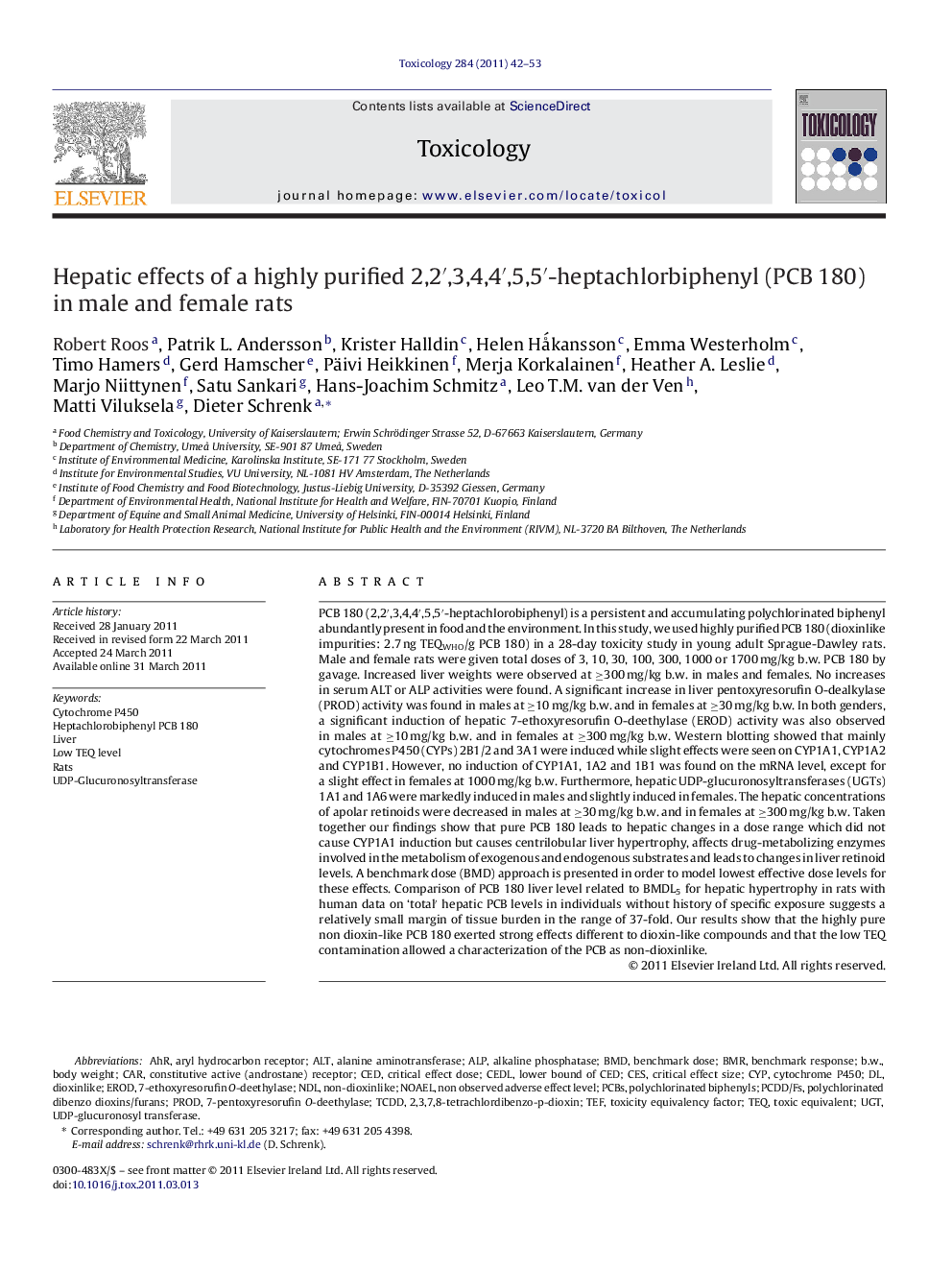| کد مقاله | کد نشریه | سال انتشار | مقاله انگلیسی | نسخه تمام متن |
|---|---|---|---|---|
| 2596159 | 1562373 | 2011 | 12 صفحه PDF | دانلود رایگان |

PCB 180 (2,2′,3,4,4′,5,5′-heptachlorobiphenyl) is a persistent and accumulating polychlorinated biphenyl abundantly present in food and the environment. In this study, we used highly purified PCB 180 (dioxinlike impurities: 2.7 ng TEQWHO/g PCB 180) in a 28-day toxicity study in young adult Sprague-Dawley rats. Male and female rats were given total doses of 3, 10, 30, 100, 300, 1000 or 1700 mg/kg b.w. PCB 180 by gavage. Increased liver weights were observed at ≥300 mg/kg b.w. in males and females. No increases in serum ALT or ALP activities were found. A significant increase in liver pentoxyresorufin O-dealkylase (PROD) activity was found in males at ≥10 mg/kg b.w. and in females at ≥30 mg/kg b.w. In both genders, a significant induction of hepatic 7-ethoxyresorufin O-deethylase (EROD) activity was also observed in males at ≥10 mg/kg b.w. and in females at ≥300 mg/kg b.w. Western blotting showed that mainly cytochromes P450 (CYPs) 2B1/2 and 3A1 were induced while slight effects were seen on CYP1A1, CYP1A2 and CYP1B1. However, no induction of CYP1A1, 1A2 and 1B1 was found on the mRNA level, except for a slight effect in females at 1000 mg/kg b.w. Furthermore, hepatic UDP-glucuronosyltransferases (UGTs) 1A1 and 1A6 were markedly induced in males and slightly induced in females. The hepatic concentrations of apolar retinoids were decreased in males at ≥30 mg/kg b.w. and in females at ≥300 mg/kg b.w. Taken together our findings show that pure PCB 180 leads to hepatic changes in a dose range which did not cause CYP1A1 induction but causes centrilobular liver hypertrophy, affects drug-metabolizing enzymes involved in the metabolism of exogenous and endogenous substrates and leads to changes in liver retinoid levels. A benchmark dose (BMD) approach is presented in order to model lowest effective dose levels for these effects. Comparison of PCB 180 liver level related to BMDL5 for hepatic hypertrophy in rats with human data on ‘total′ hepatic PCB levels in individuals without history of specific exposure suggests a relatively small margin of tissue burden in the range of 37-fold. Our results show that the highly pure non dioxin-like PCB 180 exerted strong effects different to dioxin-like compounds and that the low TEQ contamination allowed a characterization of the PCB as non-dioxinlike.
► A highly purified PCB 180 was applied to male and female rats by gavage over 28 days.
► Induction of hepatic CYP2B1/2 and 3A1 was measured on the levels of mRNA, protein, and activity.
► Induction of EROD activity but not of Ah receptor regulated CYPs was found.
► Additional parameters measured: centrilobular hypertrophy, retinoid levels, UGT activities.
► Benchmark dose calculations for all parameters are presented: the benchmark dose for hepatic hypertrophy (progression to mild effect, stage 1) was found to be in the range of 10 mg PCB 180/kg b.w. BMD (at the 5% effect level) for induction of CYP2B1 mRNA expression and PROD activity were the most sensitive parameters for hepatic effects of PCB 180 with values of 2.4 and 3.7 mg/kg b.w. per day for males, and 5.5 and 13.7 mg/kg b.w per day for females.
Journal: Toxicology - Volume 284, Issues 1–3, 18 June 2011, Pages 42–53